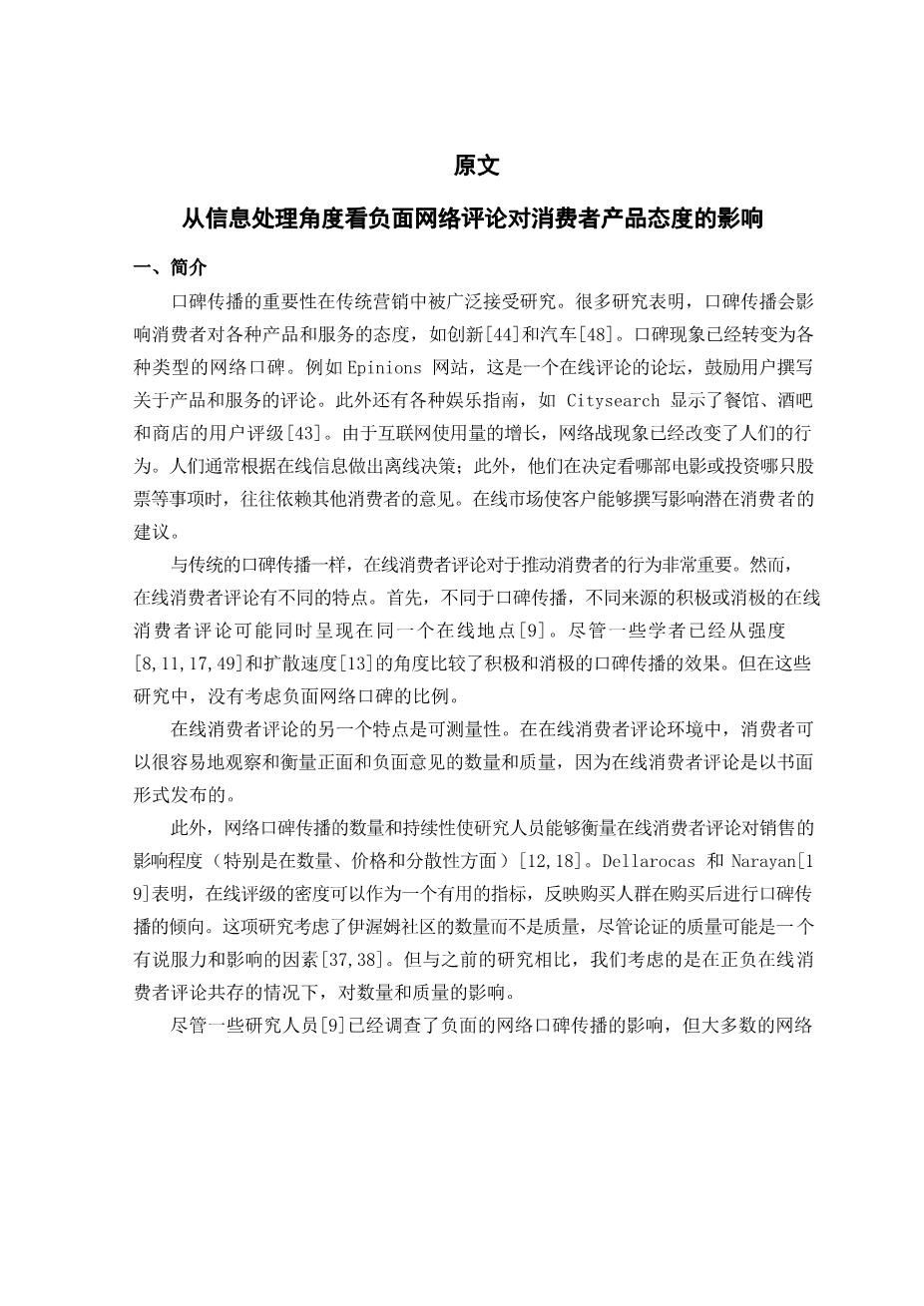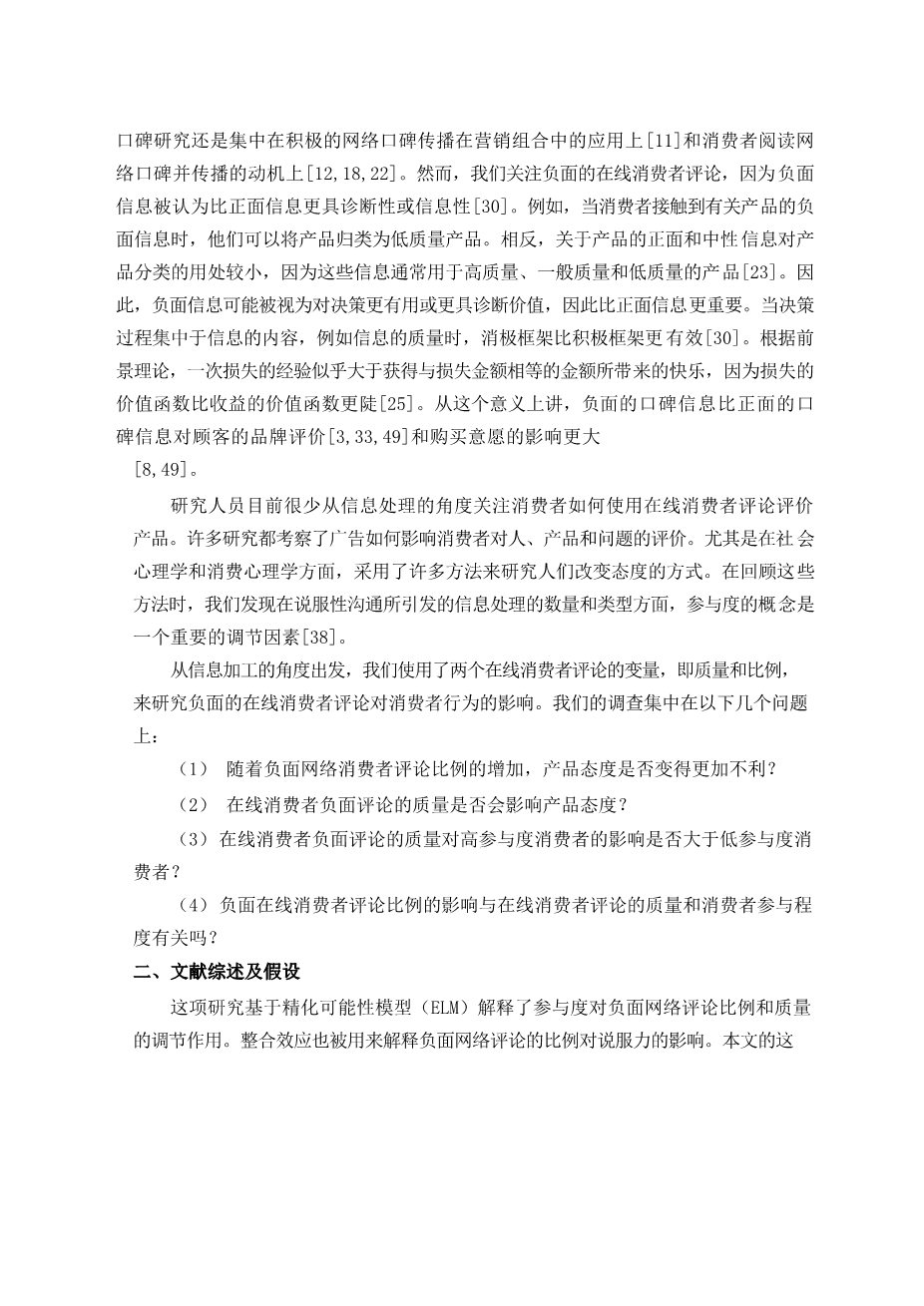Available online at www.sciencedirect.com
Electronic Commerce Research and Applications 7 (2008) 341–352
www.elsevier.com/locate/ecra
The effect of negative online consumer reviews on product attitude: An information processing view
Jumin Lee a,*, Do-Hyung Park b, Ingoo Han b
a Kyung Hee Cyber University, 1-Hoegi-Dong, Dongdaemun-Gu Seoul, 130-701, South Korea
b KAIST Business School, 207-43 Cheongrangri-Dong, Dongdaemun-Gu, Seoul 130-722, South Korea
Received 26 June 2006; received in revised form 13 October 2006; accepted 27 May 2007
Available online 2 June 2007
Abstract
Online consumer reviews provide product information and recommendations from the customer perspective. This study investigates the effects of negative online consumer reviews on consumer product attitude. In particular, it examines the proportion and quality of negative online consumer reviews from the perspective of information processing. The elaboration likelihood model is used to explain the persuasive effect of the proportion and quality depending on product involvement. A high proportion of negative online consumer reviews elicits a conformity effect. As the proportion of negative online consumer reviews increases, high-involvement consumers tend to conform to the perspective of reviewers, depending on the quality of the negative online consumer reviews; in contrast, low-involve-ment consumers tend to conform to the perspective of reviewers regardless of the quality of the negative online consumer reviews. The experiment in this study uses 248 college students in Korea. The proposed hypotheses are tested by three-way analysis of covariance.
2007 Elsevier B.V. All rights reserved.
Keywords: Electronic commerce; Online consumer reviews; Consumer behavior; Online communication; Experimental methods
1. Introduction
The importance of word-of-mouth (WOM) communica-tion is widely accepted in traditional marketing research. Many studies have shown that WOM communication affects consumer attitudes on a wide range of products and services such as innovations [44], and automobiles [48]. The WOM phenomenon has been transformed into various types of electronic WOM (eWOM) communica-tions. For example, Epinions.com, which is an online opin-ion forum, encourages users to write reviews about products and services. In addition, various entertainment guides, such as Citysearch, display the user ratings of res-taurants, bars, and shops [43]. The eWOM phenomenon has been changing peoplersquo;s behavior because of the growth of Internet usage. People often make offline decisions on the basis of online information; furthermore, they tend to rely
- Corresponding author. Tel.: 82 2 958 3685; fax: 82 2 958 3604. E-mail address: jumin04@gmail.com (J. Lee).
1567-4223/$ - see front matter 2007 Elsevier B.V. All rights reserved. doi:10.1016/j.elerap.2007.05.004
on the opinions of other consumers when making decisions about matters such as which movie to watch or what stocks to invest in [17]. The online market enables customers to write recommendations that influence potential consumers.
As with traditional WOM communications, online con-sumer reviews are important for driving the actions of con-sumers. However, online consumer reviews have different characteristics. First, unlike WOM communications, posi-tive and negative online consumer reviews are simulta-neously presented together from various sources at the same online place [9]. Although several scholars have com-pared the effects of positive and negative WOM communi-cations in terms of strength [8,11,17,49] and speed of diffusion [13]. No consideration was given in those studies to the proportion of negative WOM communications.
Another characteristic of online consumer reviews is measurability. In the online consumer review context, consumers can easily observe and measure the quantity and quality of positive and negative opinions because online consumer reviews are published in a written form.
342 J. Lee et al. / Electronic Commerce Research and Applications 7 (2008) 341–352
Furthermore, the quantity and persistence of eWOM com-munications enables researchers to measure the extent to which online consumer reviews affect sales (particularly in terms of volume, valence, and dispersion) [12,18]. Dellaro-cas and Narayan [19] showed that the density of online rat-ings can serve as a useful indicator of the purchasing populationrsquo;s propensity to engage in post-purchase WOM communications. This study considered the quantity but not the quality of eWOM communcations, though the quality of the argumentation can be a persuasive and influ-ential factor [37,38]. In contrast to previous studies, we consider the effects of both quantity and quality under con-ditions where positive and negative online consumer reviews co-exist.
Although some researchers [9] have investigated the effect of negative eWOM communications, most eWOM studies focus on the usage of positive eWOM communica-tions for a marketing mix [11] and on the motivation to read eWOM communications [12,18,22]. However, we focus on negative online consumer reviews because nega-tive information is considered more diagnostic or informa-tive than positive information [30]. For example, when consumers are exposed to negative information about a product, they can categorize the product as low in quality. In contrast, positive and neutral information about prod-ucts is less useful for categoriz
剩余内容已隐藏,支付完成后下载完整资料


英语译文共 13 页,剩余内容已隐藏,支付完成后下载完整资料
资料编号:[605511],资料为PDF文档或Word文档,PDF文档可免费转换为Word
课题毕业论文、开题报告、任务书、外文翻译、程序设计、图纸设计等资料可联系客服协助查找。
您可能感兴趣的文章
- 饮用水微生物群:一个全面的时空研究,以监测巴黎供水系统的水质外文翻译资料
- 步进电机控制和摩擦模型对复杂机械系统精确定位的影响外文翻译资料
- 具有温湿度控制的开式阴极PEM燃料电池性能的提升外文翻译资料
- 警报定时系统对驾驶员行为的影响:调查驾驶员信任的差异以及根据警报定时对警报的响应外文翻译资料
- 门禁系统的零知识认证解决方案外文翻译资料
- 车辆废气及室外环境中悬浮微粒中有机磷的含量—-个案研究外文翻译资料
- ZigBee协议对城市风力涡轮机的无线监控: 支持应用软件和传感器模块外文翻译资料
- ZigBee系统在医疗保健中提供位置信息和传感器数据传输的方案外文翻译资料
- 基于PLC的模糊控制器在污水处理系统中的应用外文翻译资料
- 光伏并联最大功率点跟踪系统独立应用程序外文翻译资料



